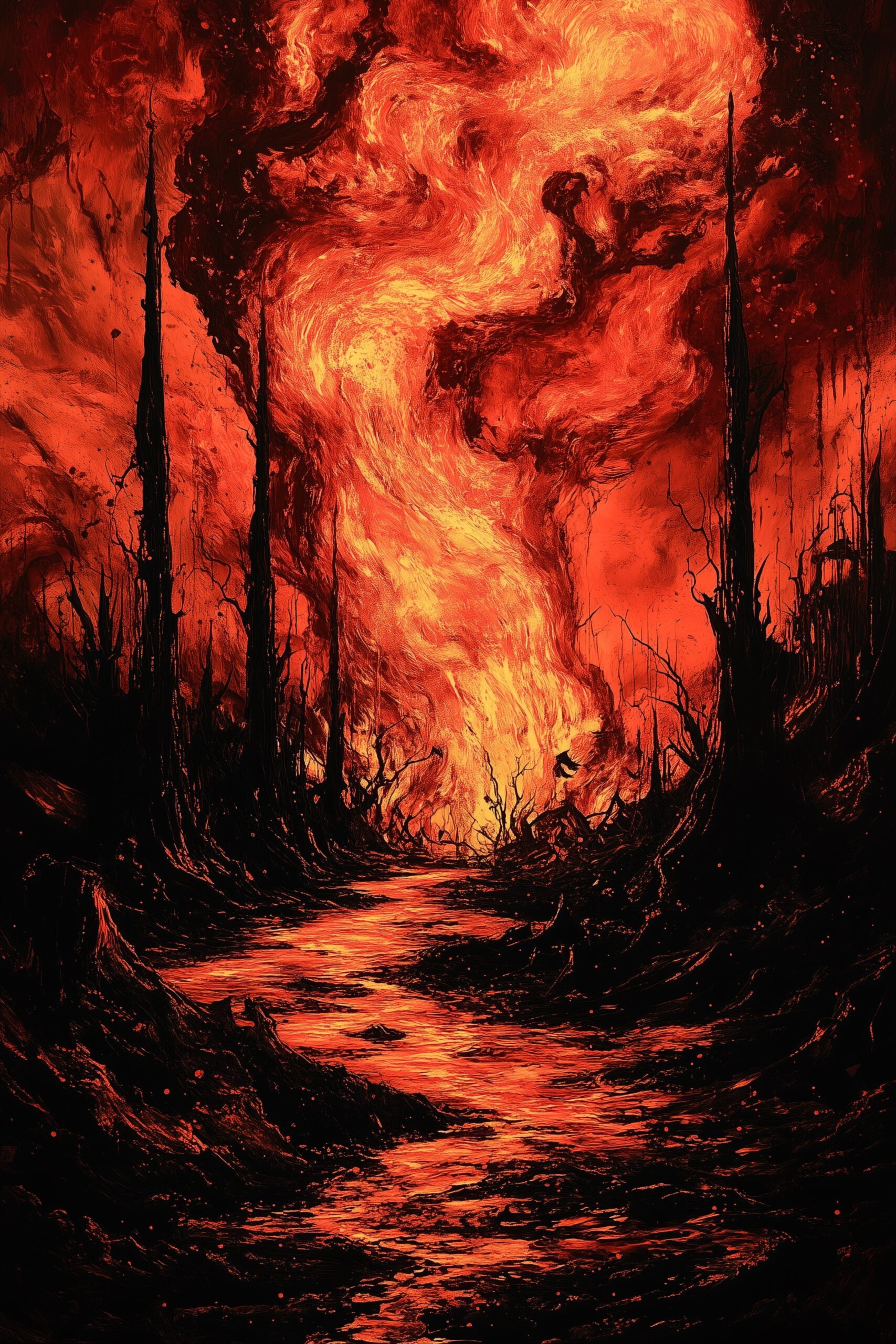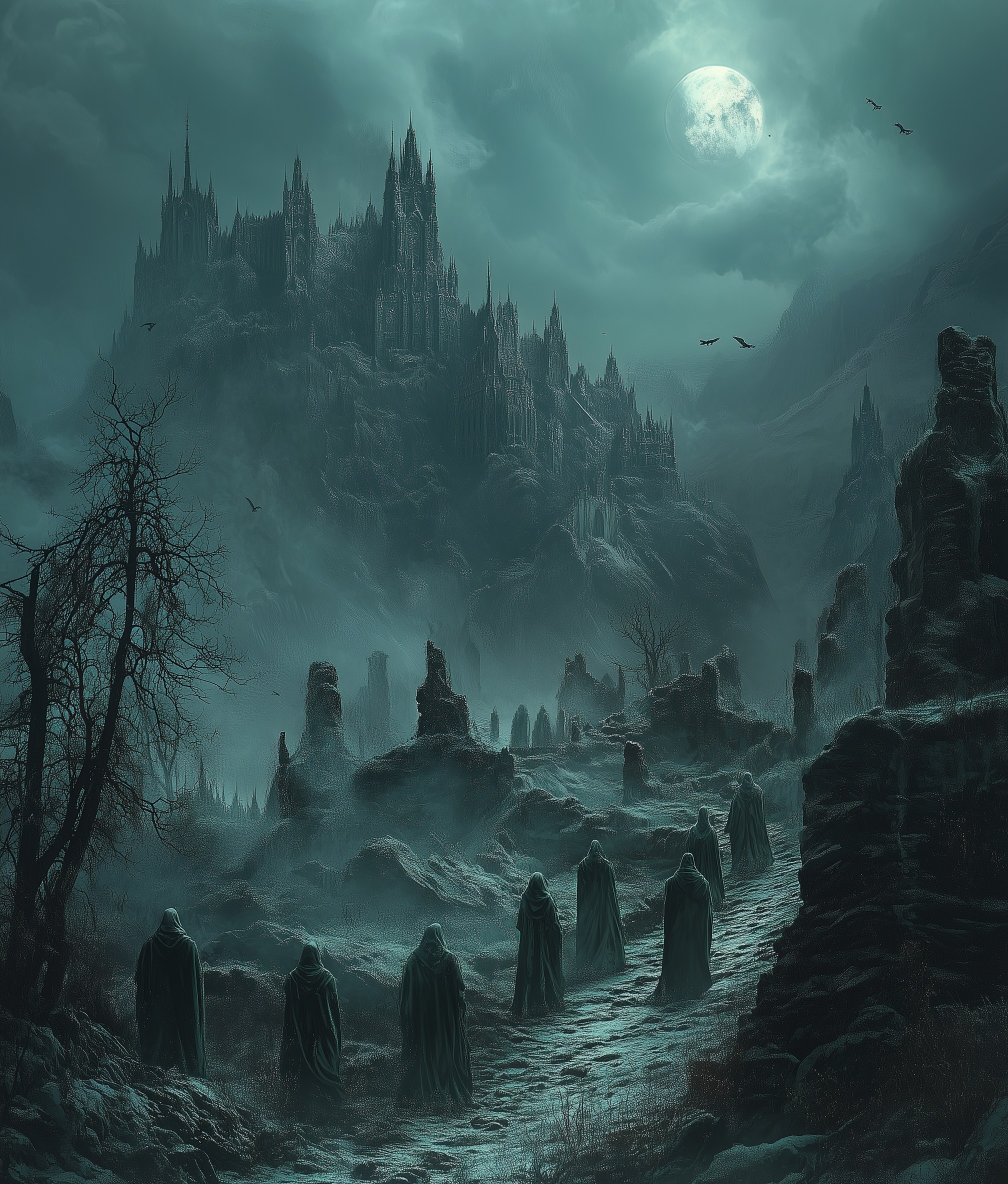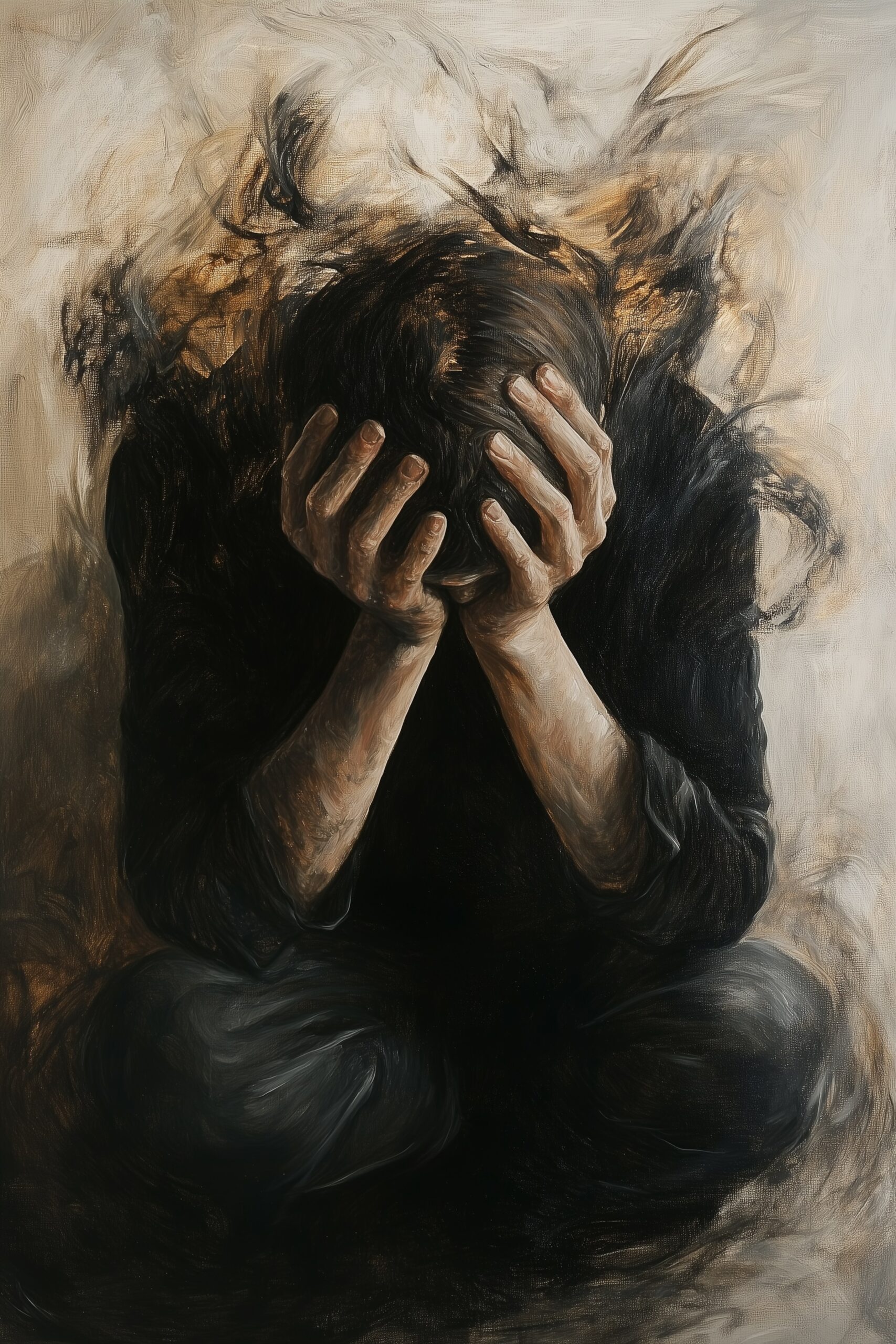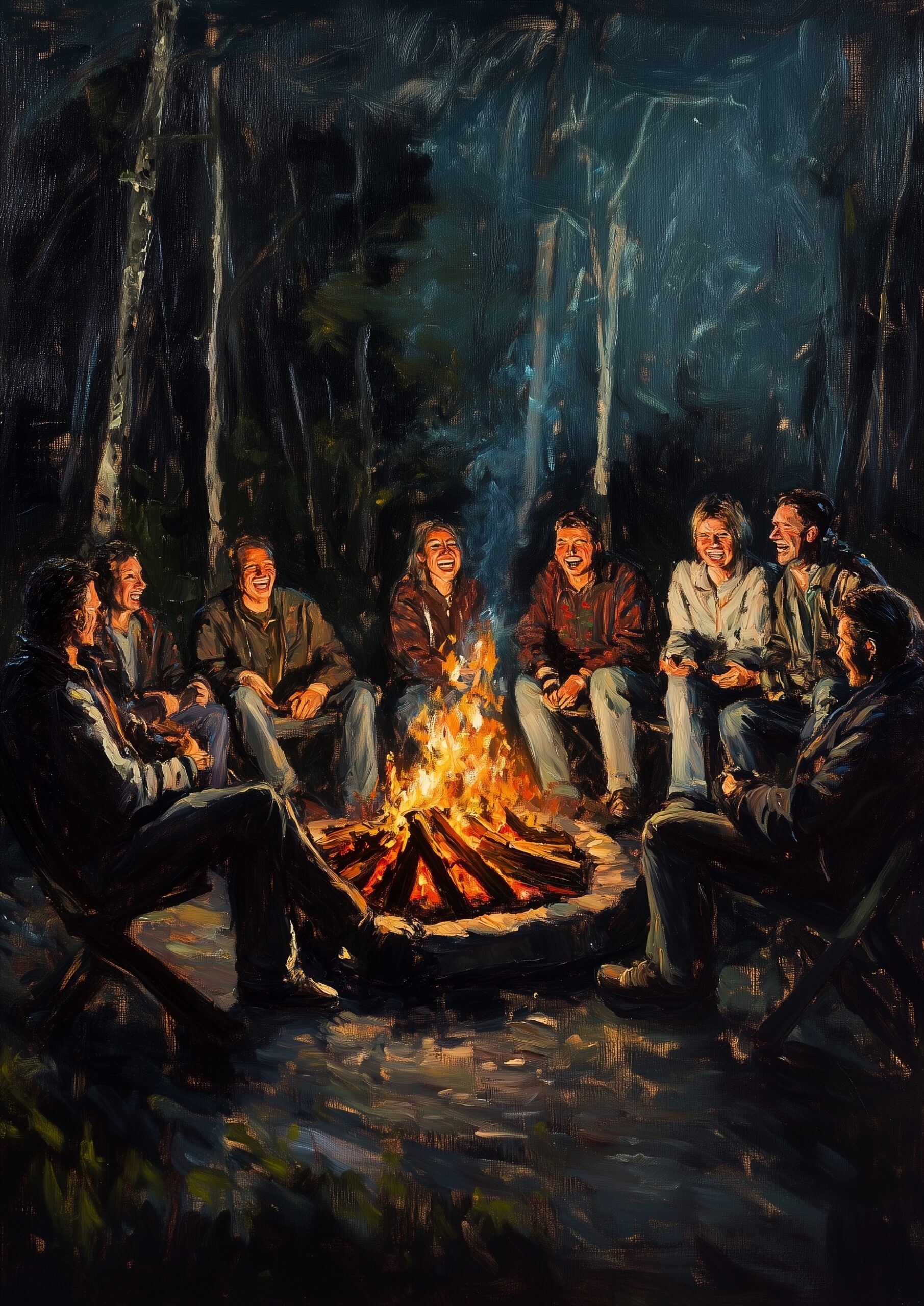
Imagine a place of eternal torment, where the soul is engulfed in unending flames. The fire burns with a heat that never diminishes, searing the flesh but never consuming it, causing perpetual agony. The air is thick with the acrid stench of sulfur, a constant reminder of the damnation that befalls those trapped within. In this place, there is no respite, no moment of peace, only the relentless suffering that stretches into infinity.
The landscape is a desolate wasteland, devoid of life and light. Shadows twist and writhe, forming grotesque shapes that reflect the inner turmoil of the condemned. There is no escape from the cacophony of anguished screams that echo endlessly, a symphony of despair that pierces the soul. The ground is barren and cracked, an eternal reminder of the separation from the divine.
Demons patrol this infernal realm, their grotesque forms instilling terror in those they torment. They inflict unimaginable pain, wielding instruments of torture designed to maximize suffering. Every moment is filled with dread, as there is no hope for redemption or reprieve. Time itself seems to stand still, each second stretching into an eternity of pain.
This vivid imagery, often depicted in Evangelical Christianity, serves as a powerful tool to instill the fear of hell. The idea of such a place creates a deep psychological and emotional impact, influencing the beliefs and behaviors of those who are taught to fear it. This fear becomes a controlling force, shaping decisions and fostering a constant sense of dread.
Definition of the Fear of Hell
The fear of hell, also known as infernophobia, is an intense and pervasive anxiety about the possibility of eternal damnation and punishment after death. This fear is deeply rooted in religious teachings, particularly in faiths that emphasize the severe consequences of sin and the necessity of salvation to avoid eternal suffering.
In many religious contexts, hell is portrayed as a place of unending torment, where souls who have not attained salvation endure eternal punishment. This depiction instills a profound fear in believers, influencing their thoughts, emotions, and behaviors. The fear of hell often starts at a young age, as vivid descriptions of this fiery abyss are used in religious education to encourage adherence to moral and doctrinal teachings.
This fear can be all-consuming, dominating one’s inner life and leading to a constant state of vigilance against sin. It can cause individuals to scrutinize their every action, thought, and intention, always fearing that they might fall short of divine expectations and be condemned to eternal damnation. This relentless self-monitoring can lead to chronic anxiety, feelings of unworthiness, and a deep-seated sense of shame.
The fear of hell can also create a dichotomous worldview, where life is seen in black and white terms of good versus evil, saved versus damned. This binary thinking can limit personal growth and understanding, as it fosters an environment where questioning and doubt are discouraged. The psychological burden of this fear is immense, often leading to long-term emotional and mental health issues.
Brief Overview of Its Prevalence and Impact
The fear of hell is a widespread phenomenon, affecting millions of people across different cultures and religions. It can lead to significant psychological and emotional distress, impacting mental health and overall well-being. This fear often manifests as anxiety, depression, and a pervasive sense of guilt and shame, which can be debilitating and difficult to overcome.
The Shadow of Hell
Origins of the Concept
The concept of hell has ancient roots, predating even organized religion. Early civilizations had myths about the afterlife, often involving a form of punishment for the wicked. These early depictions profoundly influenced later religious narratives, creating a foundation upon which more detailed ideas of hell were built. For example, the ancient Egyptians believed in a place called Duat, where souls were judged and could face annihilation if deemed unworthy. The soul’s journey through Duat was fraught with peril, and those who failed to navigate it successfully would be devoured by Ammit, a fearsome creature part lion, hippopotamus, and crocodile.
Similarly, Greek mythology introduced Tartarus, a deep abyss used as a dungeon of torment for the wicked and the Titans who opposed the Olympian gods. Tartarus was a place of utter darkness, far below even Hades, where the most severe punishments were meted out. Souls condemned to Tartarus experienced endless suffering, reinforcing the idea that there were dire consequences for defying divine order.
In Christianity, the idea of hell is strongly rooted in biblical texts. The Old Testament mentions Sheol, a place where the dead reside in a shadowy existence, lacking the vivid imagery of later depictions but still a realm of the unknown and feared. The New Testament introduces a more developed concept of hell as a place of eternal punishment, particularly in the teachings of Jesus. Jesus frequently spoke of Gehenna, a term derived from a perpetually burning garbage dump outside Jerusalem, to symbolize the fiery fate awaiting the unrighteous. This valley of Hinnom, once a site for child sacrifices, became a powerful metaphor for divine retribution.
The Book of Revelation further expands on this imagery, describing a lake of fire where the damned suffer eternally. This apocalyptic vision portrays hell as the ultimate destiny for those who reject God, a place of unending torment where “the smoke of their torment will rise forever and ever.”

During the medieval period, vivid and terrifying images of hell became popular. Writers like Dante Alighieri in his “Divine Comedy” painted elaborate and gruesome pictures of the torments awaiting sinners. Dante’s hell is a meticulously organized inferno with nine circles, each designed to punish specific sins in horrifyingly creative ways. For instance, the gluttonous are forced to lie in a vile slush produced by a ceaseless, foul, icy rain, symbolizing the cold, selfish, and empty sensuality of their lives. These detailed and graphic descriptions deeply impacted the collective imagination of the time, reinforcing the fear of eternal damnation.
Artwork from the medieval and Renaissance periods also contributed to the fearsome imagery of hell. Artists like Hieronymus Bosch depicted hell as a chaotic landscape filled with monstrous creatures and grotesque tortures, which served both as a warning to the faithful and a vivid illustration of the consequences of sin.
The evolution of the concept of hell from ancient mythologies to detailed medieval depictions illustrates how this powerful idea has been used to enforce moral behavior and religious adherence throughout history. These vivid portrayals of hell, whether through literature, art, or sermons, continue to influence modern understandings and fears of eternal punishment, demonstrating the enduring power of this concept in shaping human thought and behavior.
How It’s Taught in Different Faiths
The fear of hell is a significant element in many religious traditions, each with its unique teachings and interpretations. While the core concept of hell as a place of punishment remains consistent, the specifics can vary widely between faiths, shaping how believers perceive and react to the idea of eternal damnation.

Evangelical Christianity
In Evangelical Christianity, hell is often depicted as a fiery, torturous realm where the unrepentant face eternal suffering. This depiction is grounded in a literal interpretation of biblical texts, where hell is described as a place of “unquenchable fire” and “weeping and gnashing of teeth.” Evangelical preachers frequently use vivid and frightening imagery to convey the horrors of hell, emphasizing its reality and the urgency of salvation. The message is clear: without accepting Jesus Christ as one’s personal savior, one risks eternal damnation.
This approach serves to instill a profound fear of hell in believers, which acts as a powerful motivator for maintaining strict adherence to religious teachings and moral behavior. Evangelical churches often hold revivals and use testimonies of individuals who claim to have had near-death experiences involving visions of hell, further reinforcing the tangible threat of eternal punishment.
Catholicism
The Catholic Church teaches about hell as eternal separation from God, focusing more on spiritual anguish than physical torture. According to Catholic doctrine, hell is the state of definitive self-exclusion from communion with God and the blessed. While the imagery of fire and brimstone is present, the emphasis is on the soul’s torment due to its eternal separation from divine love.
Additionally, Catholicism introduces the concept of purgatory, a temporary state of purification for souls who have died in a state of grace but still need to undergo purification to achieve the holiness necessary to enter heaven. This belief in purgatory somewhat mitigates the fear of hell, as it offers hope for eventual redemption, unlike the more absolute and final condemnation found in some Protestant teachings.


Islam
In Islam, the concept of hell (Jahannam) is vividly described in the Quran, with various levels of punishment corresponding to the severity of one’s sins. Jahannam is depicted as a place of blazing fire, boiling water, and scorching winds, where the skin is continually burned and renewed to perpetuate the suffering. The Quranic descriptions are detailed and graphic, emphasizing the severe consequences of disobedience to God (Allah).
Muslims are taught that entry into heaven or hell is determined by their deeds, faith, and God’s mercy. The fear of Jahannam serves to encourage strict adherence to the Five Pillars of Islam, moral conduct, and repentance. Despite its severity, Islamic teachings also emphasize God’s mercy, offering hope for forgiveness and redemption for those who sincerely repent and seek to rectify their ways.
Hinduism and Buddhism
While not as central as in the Abrahamic faiths, concepts of hell exist in Hinduism and Buddhism. In Hinduism, hell (Naraka) is seen as a temporary place of punishment where souls atone for their sins before being reborn. The Garuda Purana, a Hindu scripture, describes multiple hells, each designated for specific sins, with vivid descriptions of the torments awaiting the damned, such as boiling in oil or being pierced by spears.
Similarly, Buddhism describes various hells (Naraka) as part of the cycle of rebirth (samsara). These hells are not eternal but serve as temporary states where souls experience the consequences of their karma before being reborn. The focus in Buddhism is on breaking free from the cycle of suffering through enlightenment, rather than eternal damnation.
Both Hinduism and Buddhism view these hellish experiences as part of the soul’s journey toward eventual liberation. The fear of Naraka serves to encourage ethical living and adherence to dharma (moral duty) in Hinduism and the Eightfold Path in Buddhism.


Nordic Mythology
In Nordic mythology, the concept of hell is represented by Hel, both the name of the underworld and its ruler. Hel, the place, is a cold, dreary realm where the dead reside, particularly those who did not die in battle. Unlike the fiery hells of other traditions, Hel is depicted as a place of cold and darkness, symbolizing a lack of warmth and vitality.
Hel, the goddess, presides over this realm, and while the underworld is not necessarily a place of torment, it is not a place of honor. The emphasis is on the bleakness and separation from the glory of Valhalla, where warriors go after dying heroically in battle. This separation is a form of punishment in itself, as it represents a life that did not achieve the highest ideals of bravery and honor.
Shinto
In Shinto, the indigenous spirituality of Japan, there is no single, unified concept of hell. However, the idea of Yomi, the land of the dead, bears some similarities. Yomi is a shadowy, subterranean realm where the dead go, described in the Kojiki, one of Shinto’s ancient texts. It is not a place of active punishment but a realm of decay and darkness, separated from the world of the living.
Spirits in Yomi are thought to exist in a state of impurity and stagnation. The fear associated with Yomi is more about the pollution and separation from the living world rather than active torment. Shinto rituals often focus on purification and ensuring a smooth transition to the ancestral realm, avoiding the negativity associated with Yomi.


African Traditional Religions
Many African traditional religions also have concepts of the afterlife that include realms resembling hell. For example, in some West African traditions, there is a belief in a dark, oppressive underworld where malevolent spirits dwell. These spirits are often those who led morally corrupt lives or who died in violent or dishonorable ways.
These underworlds are typically depicted as places of gloom and despair, where the spirits endure a form of punishment through separation from the community of ancestors and the living. The fear of ending up in such a place encourages adherence to communal values and moral conduct, emphasizing the interconnectedness of life, death, and the spiritual world.
Other Faiths and Perspectives
In other religious traditions, such as Judaism, the concept of hell is less emphasized and more ambiguous. Sheol, the Hebrew term often translated as “hell,” is depicted as a shadowy place where all the dead reside, regardless of their moral conduct. The afterlife focus in Judaism tends to be more on the concept of Olam Ha-Ba (the World to Come) rather than eternal punishment.
In contemporary spiritual and secular perspectives, the fear of hell is often viewed through psychological and sociocultural lenses, understanding it as a tool used historically to enforce moral behavior and social order. This modern interpretation shifts the focus from literal beliefs to the impact these beliefs have on individuals’ psychological and emotional well-being.

The Psychological Impact
Impact on Self-Worth and Identity
The fear of hell profoundly impacts an individual’s sense of self-worth and identity. When a person is raised in an environment where the concept of eternal damnation is emphasized, their self-perception becomes deeply intertwined with the notion of divine judgment and punishment. This intertwining can lead to a pervasive feeling of unworthiness, as the individual constantly fears falling short of the standards necessary to avoid hell.
Internalized Guilt and Shame
From a young age, individuals in such environments are taught to scrutinize their thoughts, actions, and even their inherent nature. They learn to see themselves through a lens of sinfulness and moral failure, internalizing a deep sense of guilt and shame. This internalized guilt can be crippling, making them feel as though they are fundamentally flawed and deserving of punishment. The belief that one’s natural inclinations or mistakes could lead to eternal damnation creates a persistent fear of judgment, both divine and communal.
The Fragmented Self
This fear of hell can lead to a fragmented sense of self, where individuals struggle to reconcile their inherent human desires and flaws with the stringent expectations of their faith. They may feel torn between their natural inclinations and the fear-driven need to suppress these parts of themselves to avoid eternal punishment. This internal conflict can prevent them from developing a cohesive and healthy sense of identity, as they continually deny or hide aspects of themselves that they fear will be judged harshly.
Perfectionism and Hyper-Vigilance
The constant fear of hell often leads to perfectionism and hyper-vigilance. Individuals may become obsessively focused on avoiding sin and adhering to religious doctrines to the letter. This perfectionism is driven by the belief that any misstep, no matter how small, could result in eternal damnation. This relentless pursuit of moral perfection is not only exhausting but also reinforces the notion that they are never good enough, no matter how hard they try.
Loss of Authenticity
In trying to meet these impossible standards, individuals may lose touch with their authentic selves. They may adopt behaviors and attitudes that align with their religious teachings, even if these do not reflect their true feelings or beliefs. This loss of authenticity can lead to a sense of emptiness and disconnection from oneself, as they are constantly performing a role rather than living genuinely.
Social Isolation
The fear of hell can also lead to social isolation, as individuals may distance themselves from others to avoid situations where they might be tempted to sin. They might also avoid people who do not share their beliefs, fearing that association with non-believers could jeopardize their salvation. This isolation can reinforce feelings of loneliness and alienation, further damaging their self-worth and sense of belonging.
Difficulty in Self-Compassion
Lastly, the fear of hell makes it challenging to practice self-compassion. Individuals may be harshly self-critical, believing that any leniency towards their own mistakes could be seen as condoning sin. This lack of self-compassion perpetuates the cycle of guilt and shame, as they struggle to forgive themselves and accept their humanity.

Mental Health Consequences
Anxiety and Depression
The fear of hell can lead to significant mental health issues, particularly anxiety and depression. These conditions are often interrelated and can severely impact an individual’s quality of life.
Constant State of Fear
Living under the constant fear of eternal damnation creates a pervasive sense of anxiety. This fear is not limited to specific situations but can become a general state of being. Individuals may experience chronic worry about their salvation, scrutinizing every thought and action for signs of sinfulness. This relentless self-monitoring can lead to generalized anxiety disorder, where the individual feels persistently on edge, expecting impending doom.
Obsessive-Compulsive Behaviors
This anxiety often manifests in obsessive-compulsive behaviors. Individuals might develop rituals or compulsions aimed at ensuring their purity and avoiding hell. These can include excessive prayer, repeated confessions, or strict adherence to religious rules and practices. While these behaviors are intended to provide a sense of control and security, they can become overwhelming and interfere with daily functioning, trapping the individual in a cycle of fear and ritual.
Panic Attacks
The fear of hell can also trigger panic attacks. These sudden episodes of intense fear and physical symptoms, such as heart palpitations, shortness of breath, and dizziness, can be terrifying and debilitating. The thought of eternal punishment can provoke such severe reactions, making the individual feel as though they are experiencing a foretaste of hell itself.
Depressive Symptoms
Alongside anxiety, the fear of hell can lead to depressive symptoms. The chronic stress and fear associated with the possibility of eternal damnation can sap an individual’s energy and sense of hope. They may feel a pervasive sense of hopelessness and helplessness, believing that no matter what they do, they can never be good enough to secure their salvation. This sense of futility can lead to major depressive disorder, characterized by persistent sadness, loss of interest in previously enjoyed activities, and significant changes in appetite and sleep patterns.
Feelings of Worthlessness
The fear of hell exacerbates feelings of worthlessness and low self-esteem. Individuals may internalize the belief that they are inherently sinful and undeserving of love and acceptance, both from others and from themselves. This internalized negative self-view can lead to deep-seated feelings of inadequacy and self-loathing, which are core features of depression.
Social Withdrawal
Depression often leads to social withdrawal, and when compounded by the fear of hell, individuals may isolate themselves even further. They might avoid social interactions to prevent situations where they might sin or be tempted. This isolation can worsen depressive symptoms, as it removes vital social support systems and increases feelings of loneliness and alienation.


Loss of Pleasure and Interest
The all-consuming fear of hell can strip away the ability to find joy and satisfaction in life. Individuals may lose interest in activities they once enjoyed, as they become preoccupied with avoiding sin and ensuring their salvation. This loss of pleasure is a hallmark symptom of depression, contributing to the overall sense of emptiness and despair.
Intrusive Thoughts and Nightmares
The fear of hell can also lead to intrusive thoughts and nightmares. Individuals might experience persistent, unwanted thoughts about hell and eternal punishment, which can be distressing and difficult to control. These intrusive thoughts can disrupt daily life and exacerbate anxiety and depression. Nightmares about hell can lead to sleep disturbances, further contributing to the individual’s mental health struggles.
Hopelessness and Suicidal Ideation
In severe cases, the fear of hell can lead to hopelessness and suicidal ideation. The belief that one is destined for eternal damnation, despite their best efforts, can drive individuals to feel that life is no longer worth living. The constant pressure and emotional pain can become unbearable, leading them to contemplate or attempt suicide as a means of escape.
Emotional Repercussions
Emotional Strain
Imagine living in a house made entirely of glass. Every room, every wall, and even the ceiling is transparent, leaving you exposed to the eyes of the world. In this house, every action, every thought, is visible and subject to scrutiny. You move through your days with the constant awareness that any misstep, any minor mistake, could shatter the fragile walls around you, leaving you vulnerable to the harsh elements outside.
Now, picture that the outside world is not filled with sympathetic onlookers but with relentless judges, waiting for the slightest flaw to condemn you to an eternal storm. This storm is not just any storm, but one of fire and brimstone, where the wind carries the cries of the damned and the rain burns like acid. The fear of this storm creeping into your glass house becomes a constant, oppressive weight on your chest.
Every day, you perform rituals to keep the storm at bay. You meticulously clean the glass, hoping that if it is spotless, no cracks will form. You rearrange your life, eliminating anything that could potentially cause a flaw in the glass. The constant vigilance required to maintain this illusion of perfection exhausts you, yet you cannot rest. The storm is always looming, and the fear of its arrival never fades.
Constant Fear and Its Effects
This metaphor illustrates the emotional toll that the constant fear of hell takes on individuals. They live their lives in a state of perpetual anxiety, feeling as though they must be perfect in every aspect to avoid the looming threat of eternal damnation. This fear seeps into every corner of their existence, dictating their actions and thoughts, and leaving them feeling exposed and vulnerable.


Guilt and Shame
In the transparent house, even the smallest mistake feels monumental. A stray thought, a moment of anger, or a lapse in judgment becomes a glaring flaw in the glass. The individual is consumed by guilt and shame, believing that these imperfections are evidence of their unworthiness and deserving of punishment. The relentless self-criticism and fear of judgment from the all-seeing eyes outside reinforce their feelings of inadequacy.
Illustrative Impact on Daily Life
Consider Sarah, a young woman who has been taught from childhood to fear hell. She wakes up each morning with a knot of anxiety in her stomach, dreading the possibility that today might be the day she fails. At work, she is meticulous to the point of obsession, double-checking every detail to ensure she makes no mistakes. She avoids social gatherings, fearful that a slip of the tongue or an unguarded moment might lead her astray.
At night, when she finally lays her head down, sleep does not come easily. Her mind races with thoughts of every perceived failing, every moment she might have fallen short. Nightmares of hellfire and damnation haunt her dreams, jolting her awake in a cold sweat. The exhaustion from her restless nights adds to her daily struggle, creating a vicious cycle of fear and fatigue.
Sarah’s relationships suffer as well. She distances herself from friends and family, worried that their influence might lead her into temptation. The isolation only deepens her despair, as she longs for connection but fears the consequences of imperfection. Her world becomes smaller and smaller, confined within the walls of her glass house, as the storm of fear rages ever closer.
Support Systems
Building a Support Network
Finding a supportive community and professional help is crucial for individuals grappling with the fear of hell. It can be challenging to break free from environments that perpetuate fear and guilt, but building a network of understanding and empathetic individuals can provide a path to healing and growth.
Creating a Safe Haven
Imagine a garden surrounded by high walls, shielding you from the storm outside. In this garden, you find shelter and solace among others who understand your experiences. This community is not judgmental or condemning but offers support and compassion. Here, you are free to express your doubts, fears, and hopes without fear of punishment.
A supportive community like this could be found in secular or progressive religious groups that focus on acceptance and personal growth rather than fear and punishment. These groups provide a safe space for questioning and deconstructing harmful beliefs, promoting an atmosphere of mutual respect and understanding.


Characteristics of a Supportive Community
- Inclusivity and Acceptance
A supportive community welcomes individuals of all backgrounds and beliefs, fostering a sense of belonging without judgment. This inclusivity allows for open discussions and shared experiences, helping individuals feel less isolated in their journey. - Focus on Healing and Growth
The community emphasizes personal development, emotional healing, and spiritual growth. Instead of focusing on fear and punishment, they encourage members to explore their beliefs, understand their emotions, and develop healthier perspectives. - Shared Experiences
Members of the community often have similar backgrounds, having experienced the fear of hell and its emotional repercussions. This shared understanding creates a bond and a sense of camaraderie, making it easier to share and heal.
Finding the Right Therapist
Choosing the right therapist is a crucial step in overcoming the fear of hell. It’s important to find a mental health professional who understands the impact of religious trauma and can offer appropriate support and guidance. Often, a more secular or non-religious therapist may be beneficial, as they can provide an unbiased perspective and focus on evidence-based therapeutic approaches.
What to Look for in a Therapist
- Specialization in Religious Trauma
Look for therapists who have experience or specialize in treating religious trauma and faith deconstruction. They will have a deeper understanding of the specific challenges you face and can offer tailored support. - Secular or Non-Judgmental Approach
A secular therapist, or one who takes a non-judgmental approach to religious beliefs, can provide a safe space to explore your fears without reinforcing them. They can help you separate your identity from the fear-based teachings you have internalized. - Compassionate and Empathetic
The right therapist should be compassionate and empathetic, providing a supportive and non-critical environment. This helps build trust and allows you to openly discuss your fears and anxieties. - Evidence-Based Practices
Therapists who use evidence-based practices, such as cognitive-behavioral therapy (CBT), mindfulness, and trauma-informed care, can offer effective strategies for managing anxiety and depression related to the fear of hell.

Navigating Community and Professional Help
Breaking Free from Fear-Based Communities
For many individuals, their existing communities may reinforce the fear of hell, making it essential to seek support outside of these environments. This can be a daunting step, as it often involves distancing oneself from long-held relationships and support systems. However, finding new communities that promote healing and acceptance is crucial for recovery.
Online Support Groups
Online support groups can be a valuable resource, especially for those who may not have access to supportive communities locally. These groups offer anonymity and a wide range of perspectives, allowing individuals to connect with others who have experienced similar struggles. Websites and forums dedicated to religious trauma and faith deconstruction can provide resources, shared stories, and a sense of community.
Local Support Groups and Meetups
Local support groups and meetups can offer face-to-face interaction and a sense of real-world community. Look for groups focused on secularism, progressive faith communities, or those specifically addressing religious trauma. Libraries, community centers, and online platforms like Meetup can be good places to find these groups.
Therapeutic Support
Engaging in therapy with a qualified professional can provide the tools and strategies needed to manage the fear of hell and its emotional repercussions. Therapy offers a structured environment to explore these fears, challenge harmful beliefs, and develop healthier coping mechanisms.
Building New Relationships
As you move away from fear-based communities, it’s important to build new, healthy relationships. Seek out individuals and groups that offer acceptance, understanding, and support. These new relationships can help reinforce positive changes and provide a network of support as you navigate your journey.
Pathways to Healing
Overcoming the Fear
Deconstructing harmful beliefs and adopting therapeutic approaches are essential steps in overcoming the fear of hell. These processes help individuals rebuild their identities and find peace and meaning outside the confines of fear-based teachings.

Deconstructing Harmful Beliefs
Understanding the Root Causes
The first step in overcoming the fear of hell is to understand its origins. This involves examining the religious teachings and cultural influences that instilled this fear. Understanding that these beliefs were taught and reinforced by external sources can help individuals begin to question and critically evaluate them.
Questioning and Reflecting
Encourage self-reflection and questioning of long-held beliefs. This can be facilitated through journaling, reading books on religious trauma and faith deconstruction, and engaging in discussions with supportive communities. Asking critical questions like, “Why do I believe this?” and “What evidence supports this belief?” can help dismantle the fear-based framework.
Seeking Alternative Perspectives
Exploring alternative religious, spiritual, or secular perspectives can provide a broader understanding of morality, existence, and the afterlife. This exploration can reveal that many cultures and belief systems do not emphasize eternal punishment, thereby reducing the fear of hell. Reading works by authors who have navigated similar journeys can offer comfort and guidance.
Therapeutic Approaches
Cognitive-Behavioral Therapy (CBT)
CBT is an effective therapeutic approach for addressing the fear of hell. It helps individuals identify and challenge irrational thoughts and beliefs, replacing them with more balanced and rational ones. A CBT therapist can work with individuals to recognize cognitive distortions related to the fear of hell and develop healthier thinking patterns.
Mindfulness and Relaxation Techniques
Mindfulness practices, such as meditation and deep breathing exercises, can help manage anxiety and reduce the emotional impact of fear. These techniques promote present-moment awareness and relaxation, helping individuals break the cycle of fear and panic associated with thoughts of hell. Mindfulness-based stress reduction (MBSR) programs can be particularly beneficial.
Trauma-Informed Therapy
For those who have experienced significant religious trauma, trauma-informed therapy provides a safe and supportive environment to process these experiences. This type of therapy recognizes the impact of trauma on mental health and focuses on healing and empowerment. Therapists trained in trauma-informed care can help individuals rebuild their sense of safety and trust.
Narrative Therapy
Narrative therapy involves exploring and reshaping one’s life story. This approach can help individuals reframe their experiences and beliefs about hell, moving from a fear-based narrative to one that emphasizes personal agency and resilience. By externalizing the fear and viewing it as a story that can be rewritten, individuals gain a sense of control over their beliefs and emotions.


Supportive Group Therapy
Group therapy sessions focused on religious trauma and faith deconstruction can provide a sense of community and shared understanding. These groups offer a space to discuss fears and experiences with others who have similar backgrounds, fostering mutual support and healing. The shared journey can help reduce feelings of isolation and reinforce positive changes.
Developing Self-Compassion
A key component of healing is developing self-compassion. This involves treating oneself with kindness and understanding, especially when dealing with fears and anxieties. Practices such as self-compassion meditation and affirmations can help individuals cultivate a gentler and more forgiving attitude towards themselves.
Building a New Identity
As individuals deconstruct harmful beliefs and engage in therapeutic practices, they can begin to build a new, healthier identity. This process involves exploring personal values, interests, and goals that are not rooted in fear. Engaging in activities that bring joy and fulfillment, such as hobbies, volunteering, or creative pursuits, can help reinforce this new sense of self.
Embracing Uncertainty
Part of overcoming the fear of hell is learning to embrace uncertainty. Accepting that some questions about life and the afterlife may remain unanswered can be liberating. It allows individuals to focus on living a meaningful and fulfilling life in the present, rather than being consumed by fear of the unknown.
Bringing It Together
The fear of hell, with its deep psychological and emotional repercussions, can profoundly affect an individual’s well-being. It can distort self-worth, fuel anxiety and depression, and create a pervasive sense of guilt and shame. However, understanding the origins of these fears and seeking supportive communities and professional help can pave the way toward healing and recovery.
By deconstructing harmful beliefs and embracing therapeutic approaches, individuals can begin to dismantle the fear-based framework that has dictated their lives. Cognitive-behavioral therapy, mindfulness practices, and trauma-informed care offer practical tools to challenge irrational thoughts and manage anxiety. Engaging in self-reflection and seeking alternative perspectives can provide a broader understanding of spirituality and morality, helping to reduce the fear of eternal damnation.
Building a supportive network is crucial for recovery. Finding communities that promote acceptance and personal growth, whether secular or progressive religious groups, can provide a safe space for questioning and healing. Connecting with compassionate therapists who specialize in religious trauma and faith deconstruction can offer personalized guidance and support.
As individuals navigate their journey toward healing, developing self-compassion and embracing uncertainty are vital. Treating oneself with kindness and understanding fosters a gentler and more forgiving attitude, while accepting life’s uncertainties allows for a focus on living meaningfully in the present.
Ultimately, overcoming the fear of hell involves rebuilding one’s identity and finding peace and fulfillment beyond fear-based teachings. It is a journey of rediscovery, where individuals can reclaim their sense of self, cultivate joy, and live authentically. Through understanding, support, and self-compassion, it is possible to break free from the shadow of hell and embrace a life grounded in hope and resilience.
